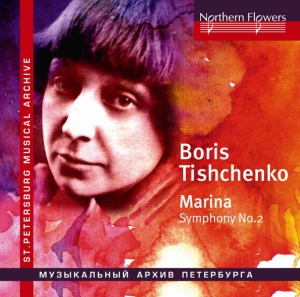CDs

NF/PMA 99105
Boris Ivanovich Tishchenko (1939-2010)
Marina. Symphony No.2 for mixed choir and large symphony orchestra to words
by Marina Tzvetayeva, Op.28 (1964)
Presto 12:33
Presto risoluto 7:15
A piacere 2:33
Andantino 9:31
Andante sostenuto 17:46
Total Time: 49:39
State Karelian Philharmonic Orchestra
Choir of the State Petrozavodsk Conservatory (Stanislaw Legkov, artistic director)
Edward Chivzhel, conductor
Recorded from the concert on December 16, 1973 at the Finnish Theater of Petrozavodsk
Boris Tishchenko: Marina. Symphony No.2
The works of Boris Ivanovich Tishchenko have a unique position in the panorama of today’s art. There is no need to remind how difficult the development of music in the 20th century was. Probably the greatest trial it had to pass was the urge towards radical innovations, which often led to the nearly complete loss of an individual style. Tishchenko’s music has a rare quality – it is instantaneously identifiable, literally by the first notes and bars. They form a world imperiously establishing its own laws and demanding maximum concentration of thought from the listener. Integrity, scale of artistic issues, and finally constant feeling of artist’s responsibility – such are the key points of the composer’s personality.
Boris Ivanovich Tishchenko completed the Second Symphony in 1964. By that time, he had already written several opuses that made him widely known, such as First Cello Concerto and First Piano Concerto, the ballet The Twelve, quartets and piano sonatas, and Inventions for Organ.
The Second Symphony is a milestone composition in the composer’s heritage; this is evident if we look at its concept, and the scope of artistic instruments. Working on the symphony, Tishchenko addressed the poetry of Marina Tsvetaeva who was not yet recognized and appreciated to the full extent in those years. The symphony is based on a cycle of four poems written in 1921 and dedicated to the personality of Marina Mniszek (daughter of a Polish voivode, wife to Pseudo-Dimitry married with him in May 1606, shortly before his violent death, and crowned as Russian Czarina). To these four poems, Tishchenko added one more written by Tsvetaeva also in 1921, related to the cycle in its general sense and summarizing its content.
Tsvetaeva read the life story of Marina Mniszek in a very peculiar key; the author tried to imagine her own life in the light of events in the biography of a Polish nobleman’s daughter (the poetess herself remarked, “…if I were to write her history I would depict myself…”) Furthermore, in the first and third poem, the main character appears in her romantically exalted dimension, as a loving and true woman, while in the second and fourth poem the historical prototype can easily be guessed in her, with all the known adventurous/negative traits. The cycle is far from a precise or literal reproduction of the historical background, but rather the personal and psychological mode of consciousness is in the forefront, presented either in first person or distantly, from the outside.
Like most of Tishchenko’s symphonies, Marina is a five-movement cycle. In addition to a large-scale orchestra, a mixed chorus sounds in all the movements of the opus, rendering an objectivistic nature to the poetic word (which distinguishes Marina from the Sixth Symphony, where female voices are used). The intense symphonic development demonstrates an extremely strong and impulsive emotional tension permeating the entire texture of the music.
The first movement opens in a biting soar of the trumpets’ theme – this material will reappear in the opus several times more, serving as its summarized intonational image. The powerful introduction performed by the chorus sounds as a decree of fate, “To be his aquiline dove! To be his Marina – more than his mother!” The music of the movement is subordinated to one motion displaying an impetuous sequence of images, a furious race, a flight through the dark of night.
The toccata of the second movement sounds even more harshly; the trenchant theme of the trumpet becomes the stem of a development enormous in its scale, where the boisterous, raging element of sounds visibly embodies the words of nightmare visions and damnations, “Self-serving blood! / – Be damned, damned be / You – who could be a Pseudo-Marina to Pseudo-Dimitry!”
The main character’s consciousness disintegrates in the relatively short third movement – the orchestral texture is torn into pieces, as the intonational material itself. It seems that nothing can put together the scattered yells and thematic fragments. The chorus part resembles now a desperate shout, and then a disjointed talk; intellect totally gives way to affect and excitement.
The fourth movement of the opus depicts the first meeting of Marina and Pseudo-Demetrius. The words of their dialogue sound emphatically noble, but the impression of a harmony is interrupted soon. The theme that opened the entire symphony reappears. It transits into a scherzoso episode that seems to disclose the underlying message of the situation, for the true thoughts of Marina are rather far from love lyrics (this becomes especially clear with the appearance of the emphatically bombastic chorus theme “In every persecuted stranger…”)
Little by little, the motion calms down, preparing the symphony’s finale – an extrapersonal summary of the entire cycle. After a restrained, tremulous prelude of the strings, the chorus enters with a magnificent and soulful theme forming the basis of the whole movement. Its declamatory and rhythmically unchained tone is softened by cantilena intonations. Just sometimes, the measured solemnity is disrupted by orchestral digression, at the very end, the sound dies away, as if proceeding “Down the reclined – and steady – Relentless slope of Tenderness,” dissolving into an illusory haze of reminiscences.
Andrei Denisov